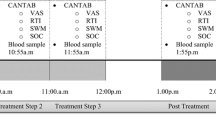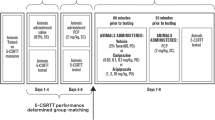Summary
The effect of a single dose of carbamazepine (CBZ), 10 mg kg−1, on a battery of simple psychomotor tests was investigated in 12 healthy subjects (6 male, 6 female) in a balanced randomised double blind placebo controlled cross-over study. Psychomotor testing and blood sampling for total and free plasma CBZ, and CBZ 10, 11 epoxide concentration were performed at 10, 12, 14, 16, 18 and 34 h after oral dosing (23.00 h the previous evening). CBZ impaired i) critical flicker fusion threshold frequency at all time points up to 18 h (p<0.005); ii) total choice reaction time at 10 h (p<0.005) and 18 h (p<0.008); iii) card sorting at 14 h (p<0.001).
No significant effect on finger tapping was noted. Subjects adjudged themselves more sedated on CBZ as compared to placebo at 12, 14 and 16 h (p<0.008). Plasma total and free CBZ concentrations (mean ± SD) peaked at 10 h (8.8±0.2 mg l−1) and 16 h (1.88±0.3 mg l−1) after dosing respectively. CBZ 10, 11 epoxide values were all less than 10% of total CBZ concentrations and, therefore, were unlikely to contribute to the pharmacodynamic effect. Total choice reaction time was significantly more impaired in females (p<0.05) but no sex difference occurred with the other tests or CBZ concentrations at any time point. No significant correlations were found between individual total or free CBZ concentrations and corresponding test performances at each time point. This study has demonstrated impairment of psychomotor function following CBZ in healthy subjects using a series of simply performed tests. This approach can now be applied to patients with epilepsy receiving long-term treatment with CBZ and other anticonvulsants.
Similar content being viewed by others
References
Andrewes DB, Tomlinson L, Elwes RDC, Reynolds EH (1984) The influence of carbamazepine and phenytoin on memory and other aspects of cognitive function in new referrals with epilepsy. Acta Neurol Scand [Suppl] 99: 23–30
Berry C, Gelder MG, Summerfield A (1965) Experimental analysis of drug effects on human performance using information theory concepts. Br J Psychol 56: 255–265
Davidson DLW (1983) Anticonvulsant drugs. Br Med J 286: 2043–2045
Dodrill CB, Troupin AS (1977) Psychotropic effects of carbamazepine in epilepsy: A double-blind comparison with phenytoin. Neurology 27: 1023–1028
Frigerio A, Morselli PL (1975) Carbamazepine: Biotransformation. In: Perry JK, Daly DD (eds) Advances in neurology, vol. 11. Raven Press, New York, pp 295–308
Hindmarch I (1980) Psychomotor function and psychoactive drugs. Br J Clin Pharmacol 10: 189–209
Hoppener RJ, Kuyer A, Meijer JWA, Hulsman J (1980) Correlation between daily fluctuations of carbamazepine serum levels and intermittent side-effects. Epilepsia 21: 341–350
Lesser RP, Pippenger CE, Luders H, Dinner DS (1984) High dose monotherapy in treatment of intractable seizures. Neurology (Cleveland) 34: 707–711
Macphee GJA, Thompson GG, Scobie G, Agnew E, Park BK, Murray T, McColl KEL, Brodie MJ (1984) Effects of cimetidine on carbamazepine auto and hetero-induction in man. Br J Clin Pharmacol 18: 411–419
Miller RG (1966) Simultaneous statistical inference. McGraw Hill, New York, pp 67–70
Perucca E, Richens A (1981) Antiepileptic drugs: Clinical aspects. In: Richens A, Marks V (eds) Therapeutic drug monitoring. Churchill Livingstone, Edinburgh, pp 320–348
Rapeport WG, Rogers KM, McCubbin T, Agnew E, Brodie MJ (1984) Treatment of intractable neurogenic pain with carbamazepine. Scott Med J 29: 162–166
Reynolds EH (1983) Mental effects of anti-epileptic medication: A review Epilepsia 24 [Suppl 2]: S85-S95
Riva R, Albani E, Ambrosetto G, Contin M, Cortelli P, Perucca E, Baruzzi A (1984) Diurnal fluctuations in free and total steady state plasma levels of carbamazepine and correlation with intermittent side-effects. Epilepsia 25: 476–481
Rodin EA, Rim CS, Rennick PM (1974) The effects of carbamazepine on patients with psychomotor epilepsy: results of a double blind study. Epilepsia 15: 547–561
Thompson PJ, Trimble MR (1982) Anticonvulsant drugs and cognitive functions. Epilepsia 23: 531–544
Thompson PJ, Trimble MR (1983) Anticonvulsant serum levels: Relationship to impairments of cognitive functioning. J Neurol Neurosurg Psychiatry 46: 227–233
Author information
Authors and Affiliations
Rights and permissions
About this article
Cite this article
MacPhee, G.J.A., Goldie, C., Roulston, D. et al. Effect of carbamazepine on psychomotor performance in näive subjects. Eur J Clin Pharmacol 30, 37–42 (1986). https://doi.org/10.1007/BF00614193
Received:
Accepted:
Issue Date:
DOI: https://doi.org/10.1007/BF00614193




